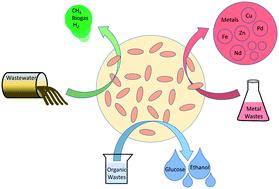当前位置:
X-MOL 学术
›
Environ. Sci.: Water Res. Technol.
›
论文详情
Our official English website, www.x-mol.net, welcomes your feedback! (Note: you will need to create a separate account there.)
Encapsulation technology to improve biological resource recovery: recent advancements and research opportunities
Environmental Science: Water Research & Technology ( IF 5 ) Pub Date : 2020-11-20 , DOI: 10.1039/d0ew00750a Siming Chen 1, 2, 3, 4 , William A. Arnold 1, 2, 3, 4 , Paige J. Novak 1, 2, 3, 4
Environmental Science: Water Research & Technology ( IF 5 ) Pub Date : 2020-11-20 , DOI: 10.1039/d0ew00750a Siming Chen 1, 2, 3, 4 , William A. Arnold 1, 2, 3, 4 , Paige J. Novak 1, 2, 3, 4
Affiliation

|
Encapsulation technology has been extensively investigated for various microbiological applications for decades. Combined with biological processes, encapsulated bacteria have great potential to efficiently and cost-effectively recover resources (e.g., hydrogen, methane, metals) from various waste streams, such as wastewater, metal wastes, and sludge. This review focuses on recent advances in four areas: encapsulation of specific bacteria or biocatalysts, effectiveness in separating the solids retention time from the hydraulic retention time, control of the encapsulant internal environment, and improved reusability and storability of encapsulated bacteria. In most cases, encapsulation technology enhanced biological resource recovery by facilitating stable high-rate operation; nevertheless, challenges remain that limit application. Consequently, this review points to three major research opportunities that, if addressed, could enable broader application of encapsulated bacteria for resource recovery: (1) encapsulant impacts on bacterial growth, leakage, and community changes with time, (2) use of encapsulant chemistry to control the encapsulant internal environment, and (3) modifications of the encapsulant matrix to improve the reusability and storage of bacteria. With the better control and predictability that should result, the use of encapsulation technology in biological processes could be further advanced as a reliable and efficient option for resource recovery.
中文翻译:

改善生物资源回收的包封技术:最新进展和研究机会
数十年来,对于各种微生物应用,已经对封装技术进行了广泛的研究。与生物过程相结合,被包埋的细菌具有巨大潜力,可以高效,经济地回收资源(例如,氢气,甲烷,金属),这些废水来自废水,金属废物和污泥等各种废物流。这篇综述集中在四个领域的最新进展:特定细菌或生物催化剂的封装,将固体保留时间与水力保留时间分开的有效性,对密封剂内部环境的控制以及提高了被封装细菌的可重复使用性和可存储性。在大多数情况下,封装技术通过促进稳定的高速率操作来增强生物资源的回收;但是,仍然存在限制应用的挑战。因此,这篇综述指出了三个主要的研究机会,如果得到解决,它们可以使包囊细菌更广泛地应用于资源回收:(1)包囊剂对细菌生长,渗漏和群落随时间变化的影响,(2)使用密封剂化学物质控制密封剂内部环境,以及(3)修改密封剂基质以提高细菌的可重复使用性和储存性。随着应产生的更好的控制和可预测性,可以进一步提高在生物过程中使用封装技术的能力,将其作为资源回收的可靠而有效的选择。
更新日期:2020-11-25
中文翻译:

改善生物资源回收的包封技术:最新进展和研究机会
数十年来,对于各种微生物应用,已经对封装技术进行了广泛的研究。与生物过程相结合,被包埋的细菌具有巨大潜力,可以高效,经济地回收资源(例如,氢气,甲烷,金属),这些废水来自废水,金属废物和污泥等各种废物流。这篇综述集中在四个领域的最新进展:特定细菌或生物催化剂的封装,将固体保留时间与水力保留时间分开的有效性,对密封剂内部环境的控制以及提高了被封装细菌的可重复使用性和可存储性。在大多数情况下,封装技术通过促进稳定的高速率操作来增强生物资源的回收;但是,仍然存在限制应用的挑战。因此,这篇综述指出了三个主要的研究机会,如果得到解决,它们可以使包囊细菌更广泛地应用于资源回收:(1)包囊剂对细菌生长,渗漏和群落随时间变化的影响,(2)使用密封剂化学物质控制密封剂内部环境,以及(3)修改密封剂基质以提高细菌的可重复使用性和储存性。随着应产生的更好的控制和可预测性,可以进一步提高在生物过程中使用封装技术的能力,将其作为资源回收的可靠而有效的选择。


























 京公网安备 11010802027423号
京公网安备 11010802027423号